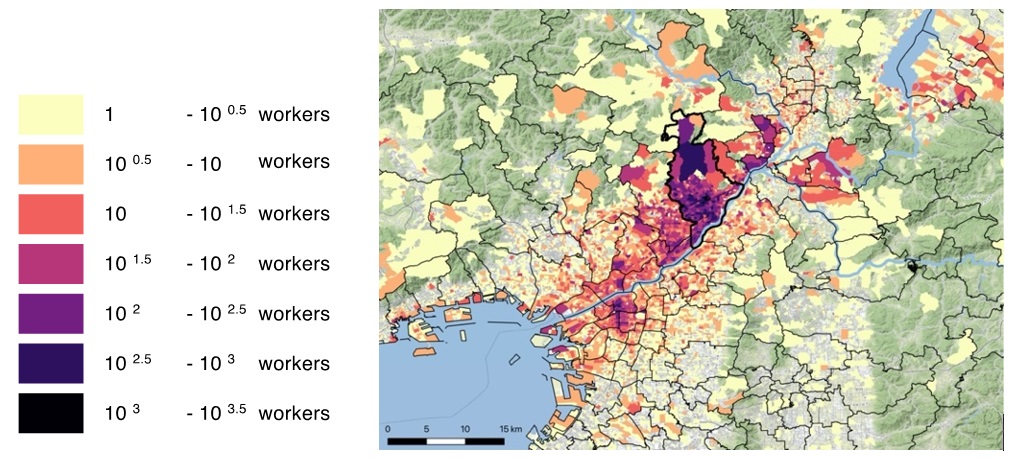Recent News Article
Kansai University and Shibaura Institute of Technology announce the joint press release
The following is the text of the joint press release announced by Kansai University and Shibaura Institute of Technology on January 19, 2023.
Novel Method for Assigning Workplaces in Synthetic Populations Unveiled
Japanese researchers pave the way to improved social simulations for guiding decision-making
Synthetic populations are computer-generated models that mimic real-world populations in terms of characteristics such as age, gender, and occupation; they are useful when conducting social simulations. In a recent study, researchers developed a new approach to assign workplaces to individuals in a synthetic Japanese population with household information, based on ODI (Origin-Destination-Industry) data. Their efforts will enable more accurate, realistic simulations of the day-time distribution of workers in Japan, helping to improve decision-making and planning.

Image Title:Workplace assignment to synthetic populations greatly potentiates social simulations
Image Link:https://ieeexplore.ieee.org/document/9941063
License Type:CC BY 4.0
Synthetic populations are computer-generated groups of people that are designed to look like real populations. They are built using public census information about people's characteristics, such as their age, gender, and job, alongside statistical algorithms that help put it all together. Their main application is for conducting so-called social simulations to assess different possible solutions to social problems, such as transportation, health issues, and housing. During the COVID-19 pandemic, for example, scientists in many places around the world conducted social simulations to estimate the number of cases in each country.
In Japan, researchers have been carrying out such simulations using supercomputers under the COVID-19 AI & Simulation Project led by the Cabinet Secretariat of the Japanese government since 2020. They were given significant consideration when deciding various political measures, such as PCR testing policies, immigration limits, domestic tourism support, vaccination programs, and so on. These simulations were possible thanks to a synthetic population which was prepared and updated under the Joint Usage/Research Center for Interdisciplinary Large-scale Information Infrastructures (JHPCN) project, since 2017.
However, this Japanese synthetic population had a significant limitation--even though a home address was one of the attributes assigned to each individual, their workplace location was not. As a result, this synthetic population was more accurate at representing the night-time distribution of people, but not their day-time distribution, or the relationship between both.
To tackle this problem, a trio of Japanese researchers including Assistant Professor Takuya Harada of Shibaura Institute of Technology, as well as Dr. Tadahiko Murata and Mr. Daiki Iwase of the Faculty of Informatics at Kansai University, recently devised a method to assign a workplace attribute to each worker in synthetic populations. Their study was published in IEEE Transactions on Computational Social Systems and was supported by both JHPCN and the Japan Science and Technology Agency (JST).
The main challenge the researchers had to overcome was the lack of statistical information linking home and workplace locations for people. In Japan, only local governments whose area has over 200,000 residents release complete origin-destination-industry (ODI) statistics, which provide details about the movement of workers as well as their industry type (like retail, construction, or manufacturing). For cities, towns, or villages with less than 200,000 residents, the available ODI data is less specific, and only tells whether the person works in the same city, in another city within the same prefecture, or in another city in a different prefecture. Unfortunately, approximately 48% of workers in Japan reside in cities with less than 200,000 residents.
Thus, the research team combined available ODI data with origin-destination (OD) data and developed an innovative workplace assignment method that works for all cities, towns, and villages in Japan. To test whether their method was designed properly, they used it to assign workplaces to people in cities with more than 200,000 residents and compared the results with the available complete ODI data. For the city of Takatsuki in the Osaka prefecture, which the researchers showcased as an example in their paper, the proposed method could assign the correct cities as workplaces for 88.2% of workers.
The possible applications for detailed social simulations using synthetic populations are manyfold, as Professor Murata of Kansai University remarks: "Real-scale social simulations can be used for estimating the efficiency of urban developments, including housing and transportation projects, as well as the influence of social programs conducted by national or local governments. They can also be employed for rescue and relief programs when facing disasters such as earthquakes, tsunamis, floods, typhoons, and pandemics." Put simply, social simulations can help decisionmakers accurately image various possible futures.
Another important aspect of synthetic populations is that they are free from data privacy concerns. "Synthetic populations are a secure technology because no private information is used," explains Assistant Professor Harada, "Because we synthesize multiple sets of populations that have the same statistical characteristics, third parties cannot identify whether real information is included or not." Worth noting, this study marks the world's first synthetic populations with workplace information that are publicly released for engineers and researchers. They can be requested at the first author's website: http://www.res.kutc.kansai-u.ac.jp/~murata/rsss-distribution/?lang=en.
The research team is already working on using their newfound workplace assignment method to estimate the day-time population distribution throughout all of Japan. It is highly probable that further progress in synthetic populations will lead to better decision-making in the near future.
Reference
| Title of original paper: | Workplace Assignment to Workers in Synthetic Populations in Japan |
| Journal | IEEE Transactions on Computational Social Systems |
| DOI: | 10.1109/TCSS.2022.3217614 |
| Authors: | Tadahiko Murata1, Daiki Iwase1, and Takuya Harada2 |
| Affiliations: | 1Faculty of Informatics, Kansai University 2College of Systems Engineering and Science, Shibaura Institute of Technology |
Funding Information
This work was supported in part by the Joint Usage and Research Center, Research Institute for Socionetwork Strategies, Kansai University; in part by the Japan Society for the Promotion of Science (JSPS) KAKENHI under Grant 20K10362; in part by the Kansai University Fund for Supporting Outlay Research Centers, 2020-2021; in part by the Japan Science and Technology Agency (JST)-Mirai Program under Grant JPMJMI20B3; in part by Joint Usage/Research Center for Interdisciplinary Large-scale Information Infrastructures (JHPCN) under Project jh210040-MDH and Project jh220051; and in part by the High Performance Computing Infrastructure in Japan under Project hp210290.
Contact
Pulbic Relations Division
Kansai University
E-mail: kouhou@ml.kandai.jp
2023/01/19 17:00 UP
- TOP
- About Kansai University
- Public Relations
- List of Recent News
- Recent News Article




